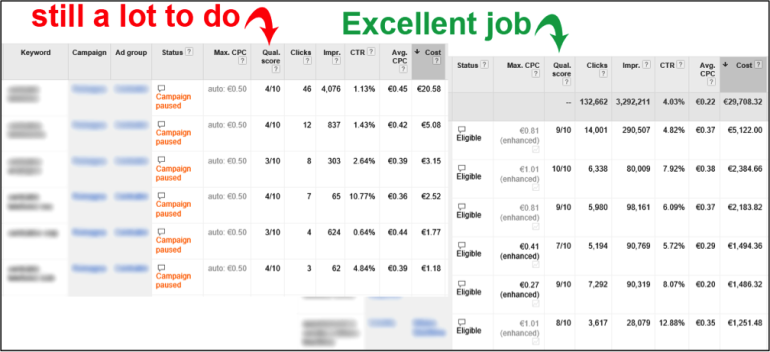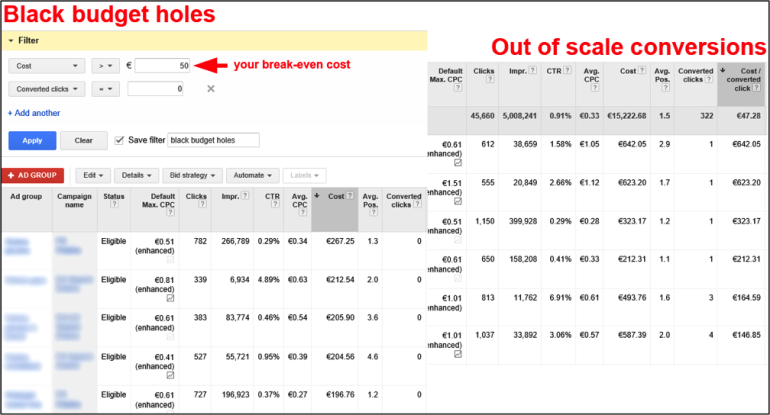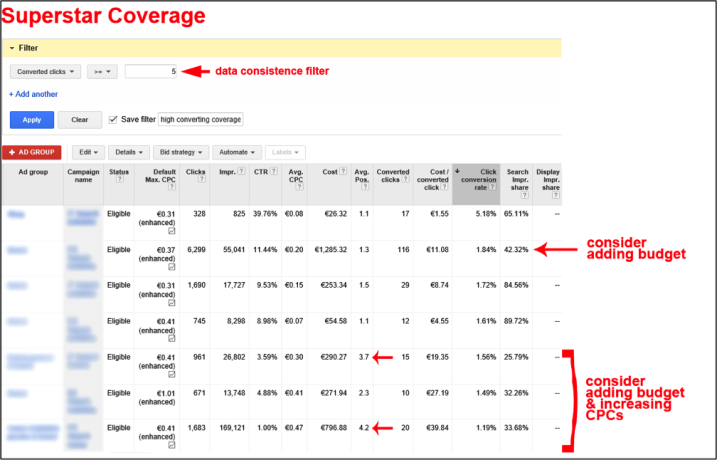In over 10 years of honored AdWords PPC management there has always been a key question to answer, especially when taking over a direct response campaign targeting leads/sales.
How optimized is this account? Or, in other words: how can I optimize this account to show improved results?
Albert Einstein once said: everything should be as simple as it can be, but not simpler.
AdWords is a powerful, but complex platform. Simple answers to these questions will probably be wrong ;-). Over the years I have found a quick and reliable way to solve the problem, without complicating too much of the evaluation process. This small procedure has proven to be suitable for both very simple, and “monster” campaigns.
Here are the Key Performance Indicator (KPIs) questions to consider:
- Efficiency – Is cost per click the lowest possible with those keywords and placements?
- Effectiveness – Are we garnering all of the conversions we can?
- Coverage – Is the budget adequate and invested in the right areas?
Efficiency is the easiest and fastest KPI to verify (at least in on the Search Network). Just activate the Quality Score personalized column and order your keywords (at account, campaign or group level) by descending total cost (in a time lag large enough to have consistent data). If the majority of your top spending keywords have a 7-10 QS, you have a very efficient account. The lower the scores are, the more optimization will be needed.
On the Display Network you can only indirectly deduce QS looking at click through rates (the higher, the better), cost per click (often significantly lower than search, except for really focused placements) and bounce rates imported from your Analytics account (the lower, the better).
With this view you can have a rough indicator of improvement areas.
Effectiveness is a little bit more complicated to audit. First of all, before assessing you need to verify if all possible conversions are tracked (and imported in AdWords, if tracked elsewhere).
An effective direct response account cannot afford to spend more on a keyword or a placement than it gains from it, however:
- It is not always easy to set a correct value for leads (even when there is a direct sale you should always consider the average lifetime value of a new customer, not only the first “shot”)
- Technical attribution problems will always depress real conversions figures
- Do not underestimate “discovery effect” and “word of mouth” value of apparently non-converting generic keywords or placements
- Always consider statistical relevance of data (the effectiveness of a keyword/placement should not be assessed without at least thousands of impressions)
Due to these factors, instead of focusing on a strict assigned goal and stop whatever goes beyond it, you should closely investigate on “out of scale” values (“black budget holes” & “performance superstars”), indulging as long as it is economically sustainable on keywords and placements that are important for your branding purposes.
Trying to understand why some keywords/placements are performing so poorly (or so good) will probably let you discover many insights about your target users and how to reach them effectively.
If your campaigns aren’t garnering enough conversions, consider also tracking clear signs of user interest, like newsletter subscriptions, reserved area registrations, pdf/docs downloads or longer than average visits (via Google Analytics).
Last but not least, coverage in terms of impression share is a key factor in deciding where to spend your money. You should always activate these columns (Search & Display) in your control panel and closely monitor. All good converting keywords or placements (your digital “cash cows”) should always have the highest possible coverage rates.
These performance superstars should always have enough budget. A good equilibrium between daily budget and real expense in these campaigns is the only way to ensure people really interested will see your ads where they are more effective. Peaks in search or impressions for these placements are your account’s performance best friends. Coverage leaks, the worst enemies. Just do not let them be eclipsed by other less performing areas of your account.
And finally, a complete optimization assessment cannot ignore unexpressed potential opportunities.
Check high CTR keywords or placements with an average position higher than 5th (which probably did not have any opportunity to eventually become cash cows) and verify periodically if there are new interesting keywords to bid for (with the suggestion tool itself).
After that, consider if you are already targeting your ideal users in all possible ways. AdWords is full with opportunities in this respect. Must have instruments like: extensions, dynamic search ads, shopping campaigns (for e-commerce sites); and some worth testing like: dynamic keywords insertion, video ads, Display & Search remarketing, similar audiences, aggressive display targeting, etc.
You could have precious insights about what your potential customers’ really want, and how to target them, using site surveys, customer satisfaction questionnaires, in line help chats and trying to interact every possible time with front desk operators.
Discovering unexpressed targeting opportunities is one of the most qualifying parts of an AdWords optimizing task. Go and get your satisfaction!







